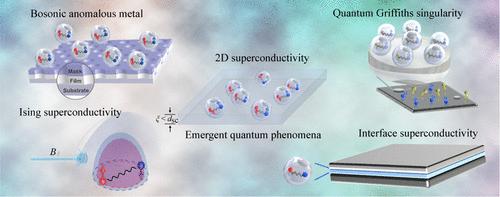当前位置:
X-MOL 学术
›
Acc. Mater. Res.
›
论文详情
Our official English website, www.x-mol.net, welcomes your
feedback! (Note: you will need to create a separate account there.)
Two-Dimensional and Interface Superconductivity in Crystalline Systems
Accounts of Materials Research ( IF 14.0 ) Pub Date : 2024-07-23 , DOI: 10.1021/accountsmr.4c00017 Haoran Ji 1 , Yi Liu 2, 3 , Chengcheng Ji 1, 4 , Jian Wang 1, 4, 5
Accounts of Materials Research ( IF 14.0 ) Pub Date : 2024-07-23 , DOI: 10.1021/accountsmr.4c00017 Haoran Ji 1 , Yi Liu 2, 3 , Chengcheng Ji 1, 4 , Jian Wang 1, 4, 5
Affiliation

|
The investigations of crystalline two-dimensional (2D) superconducting systems have become a frontier of condensed matter physics and materials science due to the emergence of novel quantum phenomena. With the reduced dimensionality, the fluctuations, the disorder effect, and the intricate interactions between electrons, spins, and orbits may impose dramatic effects on the quantum behavior of 2D superconductors. This Account reviews the recent research progress in 2D crystalline superconducting films and interfacial superconducting systems, focusing on the quantum phase transitions, emergent quantum states, and unconventional superconductivity. Six topics are introduced, including quantum Griffiths singularity, anomalous metallic state, rotational-symmetry-broken superconducting state, Ising superconductivity, interfacial high-transition temperature superconductivity, and interface-induced superconductivity. As a paradigm of quantum phase transition in 2D superconductors, the superconductor–insulator/metal transition (SIT/SMT) has been intensively studied over the last three decades, which highlights the prominent effect of disorder and quantum fluctuations. The quantum Griffiths singularity (QGS) and the anomalous metallic state revealed recently go beyond the framework of the SIT/SMT at the zero-temperature limit. The QGS of SMT was first discovered in trilayer Ga films and subsequently confirmed in various 2D superconductors. The main characteristic of QGS is a divergent critical exponent, in stark contrast to a fixed critical exponent of the conventional SIT/SMT. The anomalous metallic state, characterized by a saturating resistance at ultralow temperatures, is detected as an intervening metallic ground state that disrupts the SIT/SMT. The charge-2e quantum oscillations and the absence of the Hall effect indicate that the anomalous metallic states are dominated by the bosonic Cooper pairs instead of fermionic quasiparticles. Furthermore, the 2D systems could host various kinds of interactions and ordered states, which may be intertwined with the superconductivity. Originating from the interplay between multiple orders and strong electronic correlations, the rotational symmetry breakings are observed as in the infinite-layer nickelate superconductors, revealing the unconventional superconductivity. Arisen from the strong Zeeman-type spin–orbit coupling, the Ising superconductivity is discovered in diverse 2D superconducting systems, which features a large in-plane critical magnetic field exceeding the Pauli limit. Through interface engineering or heterostructure fabrication, the superconductivity, even high transition temperature (high-Tc) superconductivity, could be achieved at the interfaces between different materials. Moreover, the interface effect and the nontrivial topology could be introduced through interface engineering or heterostructure fabrication incorporating superconductors, insulators, semiconductors, normal metals, topological materials, etc. Consequently, the unconventional high-Tc superconductivity and the potential topological superconductivity are achieved in the interfacial superconducting systems. The experimental progress discussed in this Account suggests that the crystalline 2D and interface superconductors may offer a promising platform to study quantum phase transitions and unconventional superconducting states.
中文翻译:

晶体系统中的二维和界面超导性
由于新型量子现象的出现,晶体二维 (2D) 超导系统的研究已成为凝聚态物理学和材料科学的前沿领域。随着维数的降低,波动、无序效应以及电子、自旋和轨道之间错综复杂的相互作用可能会对二维超导体的量子行为产生巨大影响。本报告回顾了二维晶体超导薄膜和界面超导系统的最新研究进展,重点介绍了量子相变、新兴量子态和非常规超导性。介绍了六个主题,包括量子格里菲斯奇点、反常金属态、旋转对称性断裂超导态、Ising 超导、界面高转变温度超导和界面诱导超导。作为二维超导体中量子相变的范式,超导体-绝缘体/金属相变 (SIT/SMT) 在过去三十年中得到了深入研究,这突出了无序和量子涨落的突出影响。最近揭示的量子格里菲斯奇点 (QGS) 和异常金属态在零温度极限处超越了 SIT/SMT 的框架。SMT 的 QGS 首先在三层 Ga 薄膜中被发现,随后在各种 2D 超导体中得到证实。QGS 的主要特点是发散临界指数,与传统 SIT/SMT 的固定临界指数形成鲜明对比。异常金属态,以超低温下的饱和电阻为特征,被检测为破坏 SIT/SMT 的中间金属基态。 charge-2e 量子振荡和霍尔效应的缺失表明,反常金属态由玻色子 Cooper 对而不是费米子准粒子主导。此外,二维系统可以承载各种相互作用和有序状态,这些相互作用和有序状态可能与超导织在一起。源于多阶次和强电子相关性之间的相互作用,像在无限层镍酸盐超导体中一样观察到旋转对称性破坏,揭示了非常规的超导性。Ising 超导性源于强大的 Zeeman 型自旋轨道耦合,在各种 2D 超导系统中被发现,其特点是具有超过泡利极限的大面内临界磁场。通过界面工程或异质结构制造,可以在不同材料之间的界面处实现超导性,甚至高转变温度 (high-Tc) 超导性。此外,界面效应和非平凡拓扑可以通过界面工程或异质结构制造引入,包括超导体、绝缘体、半导体、普通金属、拓扑材料等。因此,在界面超导系统中实现了非常规的高 Tc 超导性和潜在的拓扑超导性。本报告讨论的实验进展表明,晶体二维和界面超导体可能为研究量子相变和非常规超导态提供一个有前途的平台。
更新日期:2024-07-23
中文翻译:

晶体系统中的二维和界面超导性
由于新型量子现象的出现,晶体二维 (2D) 超导系统的研究已成为凝聚态物理学和材料科学的前沿领域。随着维数的降低,波动、无序效应以及电子、自旋和轨道之间错综复杂的相互作用可能会对二维超导体的量子行为产生巨大影响。本报告回顾了二维晶体超导薄膜和界面超导系统的最新研究进展,重点介绍了量子相变、新兴量子态和非常规超导性。介绍了六个主题,包括量子格里菲斯奇点、反常金属态、旋转对称性断裂超导态、Ising 超导、界面高转变温度超导和界面诱导超导。作为二维超导体中量子相变的范式,超导体-绝缘体/金属相变 (SIT/SMT) 在过去三十年中得到了深入研究,这突出了无序和量子涨落的突出影响。最近揭示的量子格里菲斯奇点 (QGS) 和异常金属态在零温度极限处超越了 SIT/SMT 的框架。SMT 的 QGS 首先在三层 Ga 薄膜中被发现,随后在各种 2D 超导体中得到证实。QGS 的主要特点是发散临界指数,与传统 SIT/SMT 的固定临界指数形成鲜明对比。异常金属态,以超低温下的饱和电阻为特征,被检测为破坏 SIT/SMT 的中间金属基态。 charge-2e 量子振荡和霍尔效应的缺失表明,反常金属态由玻色子 Cooper 对而不是费米子准粒子主导。此外,二维系统可以承载各种相互作用和有序状态,这些相互作用和有序状态可能与超导织在一起。源于多阶次和强电子相关性之间的相互作用,像在无限层镍酸盐超导体中一样观察到旋转对称性破坏,揭示了非常规的超导性。Ising 超导性源于强大的 Zeeman 型自旋轨道耦合,在各种 2D 超导系统中被发现,其特点是具有超过泡利极限的大面内临界磁场。通过界面工程或异质结构制造,可以在不同材料之间的界面处实现超导性,甚至高转变温度 (high-Tc) 超导性。此外,界面效应和非平凡拓扑可以通过界面工程或异质结构制造引入,包括超导体、绝缘体、半导体、普通金属、拓扑材料等。因此,在界面超导系统中实现了非常规的高 Tc 超导性和潜在的拓扑超导性。本报告讨论的实验进展表明,晶体二维和界面超导体可能为研究量子相变和非常规超导态提供一个有前途的平台。


















































 京公网安备 11010802027423号
京公网安备 11010802027423号